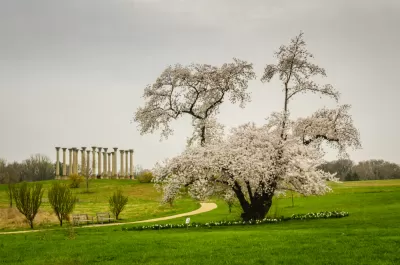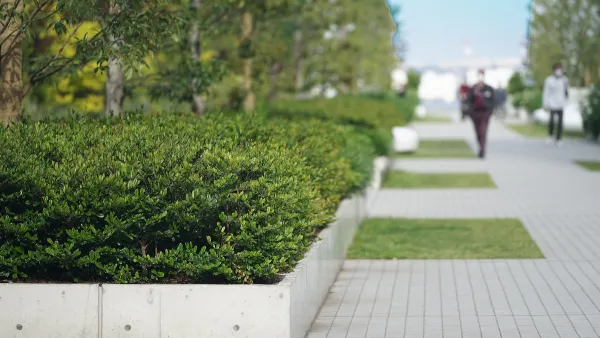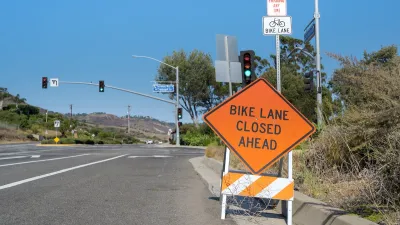Rain gardens and bioswales have allowed DC Water to scale back on the "gray infrastructure" it's building while still keeping rivers clean.

Next to Washington D.C.’s Piney Branch Parkway, right across from where that road intersects with 17th Street NW, CSO-049 serves the Rock Creek Sewershed, a 2,329-acre area of Washington D.C., with a diverse, mixed-income population of close to 90,000.
CSO-049 is the end of a pipe, part of D.C.’s sewer system. In an average year, 39.73 million gallons of combined stormwater and raw sewage flow out from CSO-049, dumping feces-polluted water into Piney Branch, which flows into Rock Creek just upstream from the Smithsonian’s National Zoo, and historic neighborhoods like Mount Pleasant, Dupont Circle, and Georgetown.
But most of the time, CSO-049 is dormant. The acronym “CSO” stands for “combined sewer overflow,” and CSO points like these are a feature of combined sewer systems designed and built mostly more than a century ago. In combined sewer systems, storm drains capture rainwater runoff — and any pollutants it picks up along the way — and sends it into the same sewers that collect wastewater from homes and businesses. On most rainy days, it all flows to wastewater treatment facilities that are supposed to remove toxins and other pollutants before releasing it back into natural bodies of water.
During heavier rainfall, however, combined sewer systems can’t handle the volume, sending the mixture directly out from overflow points like CSO-049, one of around 50 such overflow points in the District. And today, because of climate change, heavy storms are occurring more frequently, causing more of these overflow incidents in cities that have combined sewer systems.
Most cities facing this challenge have responded using what’s known as “gray infrastructure” — digging massive new underground tunnels or enlarging existing ones to capture and store stormwater until it can flow to wastewater treatment plants. An alternative, which a growing but still small number of cities are starting to embrace, is “green infrastructure” — rain gardens, bioswales, tree trenches, permeable pavement, green roofs and other forms that combine old and new technology to absorb more rainwater where it falls.
D.C. has already spent or committed nearly $2 billion over the past decade to building gray infrastructure, building massive tunnels deep beneath the Anacostia and Potomac rivers, as large as the tunnels that carry the region’s metro trains. But the District recently marked a major milestone in its gradual embrace of green infrastructure, declaring its first green infrastructure pilot project a success and shifting to a hybrid green-gray infrastructure approach for the final phases of its court-mandated, $2.7 billion stormwater management plan known as the Clean Rivers Project.
FULL STORY: ‘Green Infrastructure’ for Clean Water Shows Its Worth in Washington, D.C.

Maui's Vacation Rental Debate Turns Ugly
Verbal attacks, misinformation campaigns and fistfights plague a high-stakes debate to convert thousands of vacation rentals into long-term housing.

Planetizen Federal Action Tracker
A weekly monitor of how Trump’s orders and actions are impacting planners and planning in America.

San Francisco Suspends Traffic Calming Amidst Record Deaths
Citing “a challenging fiscal landscape,” the city will cease the program on the heels of 42 traffic deaths, including 24 pedestrians.

In U.S., Urban Gondolas Face Uphill Battle
Cities in Latin America and Europe have embraced aerial transitways — AKA gondolas — as sustainable, convenient urban transport, especially in tricky geographies. American cities have yet to catch up.

Detroit Says Problems With Property Tax Assessments are Fixed. Advocates Disagree.
With higher-valued properties under assessed and lower-valued properties over assessed, advocates say there's still a problem with Detroit's property tax system.

Defunct Pittsburgh Power Plant to Become Residential Tower
A decommissioned steam heat plant will be redeveloped into almost 100 affordable housing units.
Urban Design for Planners 1: Software Tools
This six-course series explores essential urban design concepts using open source software and equips planners with the tools they need to participate fully in the urban design process.
Planning for Universal Design
Learn the tools for implementing Universal Design in planning regulations.
Heyer Gruel & Associates PA
JM Goldson LLC
Custer County Colorado
City of Camden Redevelopment Agency
City of Astoria
Transportation Research & Education Center (TREC) at Portland State University
Jefferson Parish Government
Camden Redevelopment Agency
City of Claremont





























